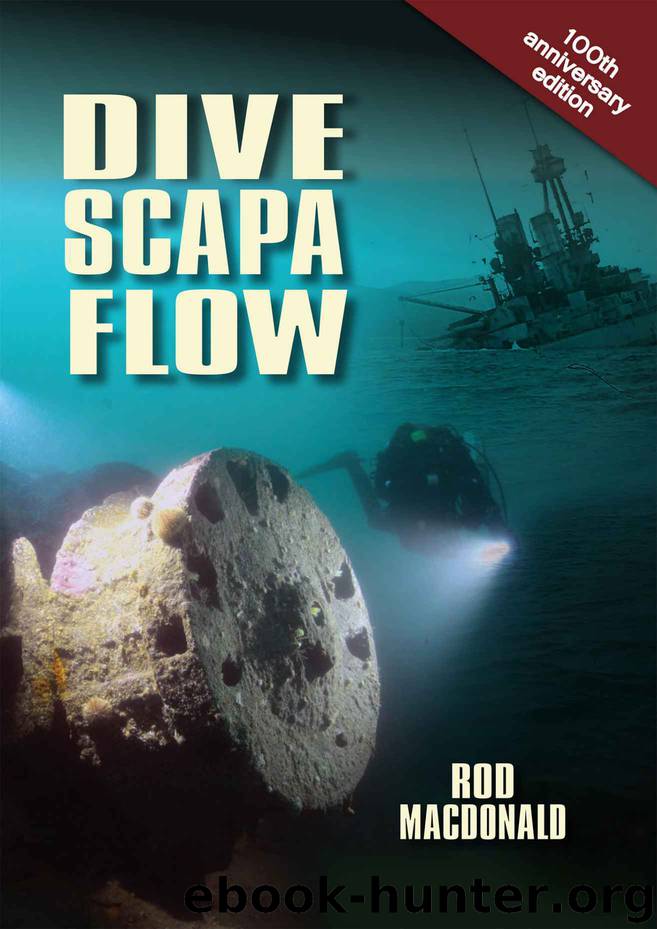Dive Scapa Flow by Rod Macdonald

Author:Rod Macdonald [Macdonald, Rod]
Language: eng
Format: azw3
ISBN: 9781849953764
Publisher: Whittles Publishing
Published: 2017-11-07T05:00:00+00:00
Artist’s illustration of SMS Brummer as she was in the 1990s. Areas of the wreck have collapsed significantly since then.
Keel aspect of the wreck of Brummer – bow to left – showing engine room salvage blast damage, bilge keels and rudder. Image courtesy of Chris Rowland. Data © ADUS Deepocean
Forward 5.9-inch gun fallen to seabed (gun shield to left) with its barrel partly obscured by fallen deck plates. © Bob Anderson
The ship was moored with her starboard anchor at the time of the scuttle. Both chains rise up from the chain locker below decks, through spurling pipes to two large circular steam capstans that were set side by side on the foredeck in front of the forward 5.9-inch gun. The starboard chain runs from its capstan out through its hawse pipe to the seabed. The uppermost port anchor is missing from its hawse.
The two deck-mounted capstans each had an axle that ran down through the ship for several decks to a dedicated steam driven engine and donkey boiler situated at the bottom of the ship, on the lower platform deck. The axles had auxiliary circular drums where levers or bars could be inserted into square holes that allowed manual turning of the axle by gangs of crew if necessary to raise the anchors. In the deck below the main upper deck, the middle deck, there were similar circular drums with square notches where additional crew could manually operate the capstan.
The foredeck 5.9-inch deck gun remained in situ, defying gravity on the centre line of the vessel, for more than 80 years until 2003, when it fell from its mount to the seabed. Here it now rests with its barrel pointing slightly upwards. As it tore free of the deck, its weight ripped, buckled and weakened the surrounding deck plating and ribs – and this set in motion a chain of further progressive collapsing of this area over the succeeding years. In 2010 there was a significant collapse of this area as decking, distressed by the earlier collapse of the bow gun and the disintegration of rivets through differential corrosion, peeled away from the hull and fell, to partly obscure the bow gun and fire control tower.
Immediately behind the fallen 5.9-inch bow gun sits the fire control tower – with its 3.8-inch thick armour and thin viewing slits ringed round it, some still with their thick glass in place. The tower has fallen away with the deck from the hull and now rests on the seabed at an angle of about 40 degrees – it is heavily obscured by fallen decking. The aft door into the tower is open, but its contents were removed long ago.
On top of the fire control tower sat a large winged optical rangefinder. From the greater safety of this armoured fire control tower, the ship’s officers would have directed operations whilst Brummer was in battle. In the uppermost level of the tower was stationed the gunnery officer responsible for rangefinding for the guns. On the level below would be a helmsman who could steer the vessel under fire.
Download
This site does not store any files on its server. We only index and link to content provided by other sites. Please contact the content providers to delete copyright contents if any and email us, we'll remove relevant links or contents immediately.
| Africa | Americas |
| Arctic & Antarctica | Asia |
| Australia & Oceania | Europe |
| Middle East | Russia |
| United States | World |
| Ancient Civilizations | Military |
| Historical Study & Educational Resources |
Room 212 by Kate Stewart(4742)
The Crown by Robert Lacey(4578)
Endurance: Shackleton's Incredible Voyage by Alfred Lansing(4513)
The Iron Duke by The Iron Duke(4126)
The Rape of Nanking by Iris Chang(4024)
Killing England by Bill O'Reilly(3900)
Joan of Arc by Mary Gordon(3792)
Say Nothing by Patrick Radden Keefe(3731)
I'll Give You the Sun by Jandy Nelson(3275)
Shadow of Night by Deborah Harkness(3181)
Hitler's Monsters by Eric Kurlander(3168)
Mary, Queen of Scots, and the Murder of Lord Darnley by Alison Weir(3071)
Blood and Sand by Alex Von Tunzelmann(3060)
Darkest Hour by Anthony McCarten(3019)
Margaret Thatcher: The Autobiography by Thatcher Margaret(2972)
Eleanor & Park by Rainbow Rowell(2946)
Red Famine: Stalin's War on Ukraine by Anne Applebaum(2817)
Book of Life by Deborah Harkness(2725)
The One Memory of Flora Banks by Emily Barr(2687)
